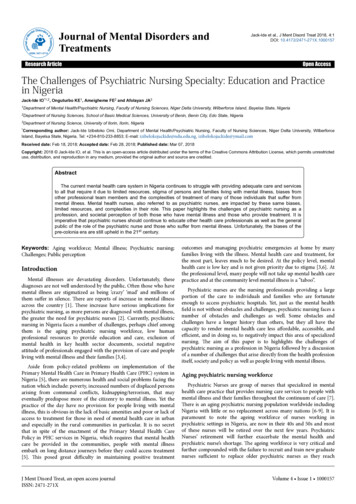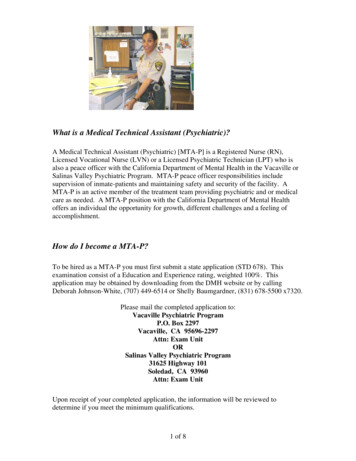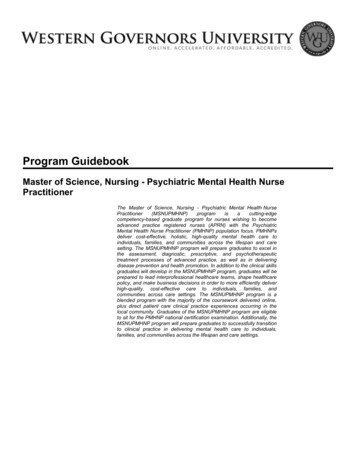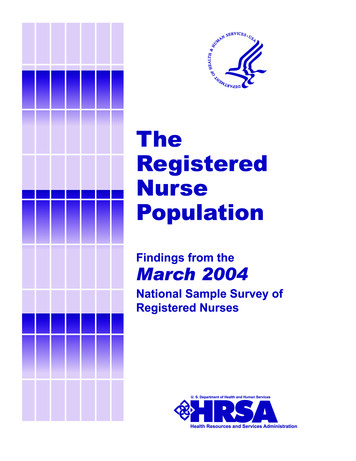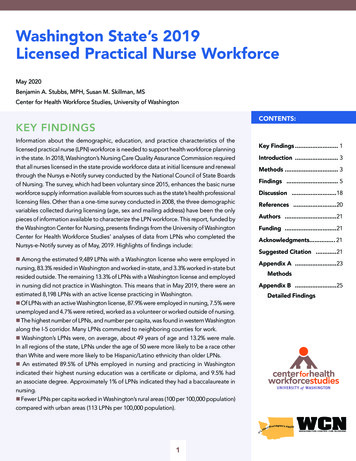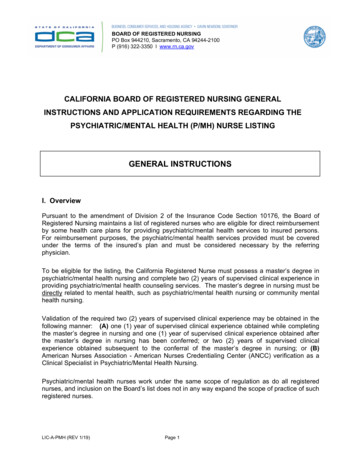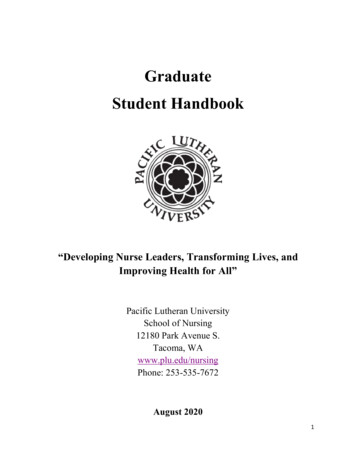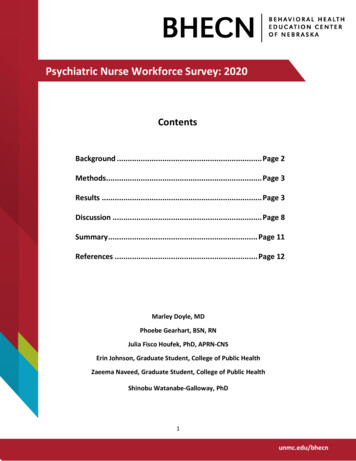
Transcription
Psychiatric Nurse Workforce Survey: 2020ContentsBackground . Page 2Methods. Page 3Results . Page 3Discussion . Page 8Summary . Page 11References . Page 12Marley Doyle, MDPhoebe Gearhart, BSN, RNJulia Fisco Houfek, PhD, APRN-CNSErin Johnson, Graduate Student, College of Public HealthZaeema Naveed, Graduate Student, College of Public HealthShinobu Watanabe-Galloway, PhD1unmc.edu/bhecn
BACKGROUNDRegistered Nurses (RNs) and Licensed Practical Nurses (LPNs) provide essential health care servicesthroughout Nebraska. There is a growing recognition that psychiatric care is an integral component ofessential health care services, contributing to improved physical as well as mental health (van der Sluijs,et al., 2018). As the demand for psychiatric services increases, it is important to determine the capacity ofthe Nebraska Nursing workforce to provide psychiatric and mental health care.Psychiatric Nursing. Evolving models of health-care delivery (e.g., integration of mental health care intoprimary care, managed-care insurance plans, and team-based care) require a 21st Century Health-CareWorkforce Agenda that integrates demand, capacity, and capabilities of psychiatric care providers(Delany, 2016). Nursing education prepares RNs to monitor patients’ health status, provide interventionsto promote or restore health, educate patients about self-care, and coordinate care in several clinicalspecialties, including psychiatric mental health nursing (APNA, 2019; Delaney, 2016). LPNs are educatedto provide basic nursing care under the supervision of registered nurses or other licensed providers(Nebraska Department of Health and Human Services) in a variety of health-care settings. Thebiopsychosocial foundation of nursing education provides a strong and flexible framework for nurses toprovide integrated, team-based mental and physical health care in both primary care and psychiatric caresettings within their scope of nursing practice. Nonetheless, in response to burgeoning health-careknowledge and competition among nursing specialties for content inclusion in nursing curricula,psychiatric mental health nursing content and clinical experiences have decreased over time (Adams,2015). These changes provide fewer psychiatric mental health nursing learning opportunities for nursingstudents. In addition, Phoenix (2019) posits that the psychiatric mental health nursing specialty is at adisadvantage for recruiting nurses into the specialty because the work, which is relationship-based, doesnot involve visual signifiers (e.g., scrubs, stethoscopes) typically used to represent nursing as a career.Nebraska Nursing Statistics. The Nebraska 2018 RN (N 29,062) and 2017 LPN (N 5,671) License RenewalSurveys indicate that the majority of licensed nurses practice in urban areas. 1 Approximately two-thirds(63.6%) of RNs work in Douglas and Lancaster counties (Ramirez, 2019). Similarly, 77% of LPNs work inurban areas (Ramirez, 1918). The prevalence of nurses in urban areas of Nebraska mirrors the populationdistribution (USDA-ERS, 2018) as well as the distribution of mental health providers. Only three counties,located in eastern Nebraska, are considered mental health non-shortage (Sarpy and Cass) or partialshortage (Douglas) areas (Rural Health Information Hub, 2019). Approximately a third of Nebraskacounties (33 of 93) do not have any mental health providers (Hoebelheinrick & Ramirez, 2019). Thedisproportionate distribution of nurses and mental health providers limits the ability of rural healthhospitals and clinics to deliver psychiatric care.Psychiatric mental health (PMH) nurses comprise the second largest group of behavioral healthprofessionals in the United States (Phoenix, 2019). An estimated 4% of the U.S. RNs report psychiatricmental health and substance abuse as their primary nursing specialty (Smiley, et al., 2018). In comparison,641 (2.7%) (RNs and Advanced Practice Registered Nurses [APRNs] combined) who responded to the 2018Completion of the surveys is voluntary and completed by most, but not all, nurses at the time of license renewal.Therefore, the number of RNs and LPNs responding to the survey is less than the number of licensed RNs and LPNsin Nebraska for the renewal period. In addition, the survey data cited here pertain to RNs and LPNs who work inNebraska, which represents approximately 80 % of licensed NE nurses. (Personal communication J. Reznicek,K.Hoebelheinrich, & J-P. Ramirez, July 2-3, 2020).12
Nebraska RN License Renewal Survey chose PMH nursing as their primary practice focus (Hoebelheinrick& Ramirez, 2019). Hoebelheinrick and Ramirez presented additional demographic and workforcecharacteristics of Nebraska PMH nurses. Approximately 96% (n 613) of Nebraska PMH nurses work in 12urban counties. The majority of PMH nurses practice as RNs (n 510; 79.6%) in psychiatric facilities (n 267;50.7%). Other practice settings selected by PMH RNs include hospitals (n 165; 31.3%) and clinics (n 17;3.2%). With regard to age, which is an important factor with regard to future workforce projections, PMHnurses (RNs and APRNs) are four years older on average compared to all Nebraska RNs (48 years vs. 44years, respectively). Although practice focus is not available from the 2017 LPN Renewal Survey, onethird (33.9%) work in long-term care, 23.2% in ambulatory care, and 10.7% in hospitals (Ramirez, 2018).The average age of Nebraska LPNs is 46 years.To better determine the current employment of and need for psychiatric RNs and LPNs in Nebraska, thecurrent survey gathered data from hospital and clinic administrators.METHODSThe survey was executed by the University of Nebraska’s Health Professional Tracking Service (HPTS). Apaper-based survey with return envelope was mailed to facilities identified as potentially utilizingpsychiatric nurses; Nebraska hospitals and clinics with health care professionals (MDs, DOs, APRNs, orPAs) identified as practicing psychiatry. The survey requested information from the facility perspectiveregarding the availability, employment, and utilization of employed and contracted psychiatric nurses.The completed survey could be returned via mail, email or fax. A total of 180 facilities received the survey(rural 57, urban 123).RESULTSThe response rate was 42.3% for urban facilities (52 facilities) and 50.9% for rural facilities (29 facilities).Of the 52 urban facilities, 21 (40.4%) indicated that they employ or contract for RN or LPN psychiatricnurses whereas of the 29 rural facilities, 9 (31.0%) indicated that they employ or contract for RN or LPNpsychiatric nurses (Table 1).Table 1. Number and percentage of facilities that employ or contract RN or LPN psychiatric nursesEmployed or contracted RN orLPN psychiatric nurseYesNoUrban (n 52)Number (percentage)21 (40.4)31 (59.6)Rural (n 29)Number (percentage)9 (31.0)19 (69.0)Reasons for not employing or contracting for psychiatric nurses. Respondents provided the followingreasons for not employing or contracting for psychiatric nurses:Urban: Lack of availability of PMH nurses and funding (1 facility) No need for PMH nurse (solo practice, business just starting, not taking psychiatric referrals fromAPNRs) (6 facilities)Rural: Limited or lack of funding or resources (2 facilities) Lack of candidate (1 facility) No need for PMH nurse (do not treat psychiatric patients, Psych NP provides care) (3 facilities)3
Number of RN or LPN psychiatric nurses working at facilities. A total of 29 facilities (20 urban and 9 rural)reported the number of RN and LPN psychiatric nurses working at the facilities (Table 2). As shown inFigure 1, the largest number of nurses employed was full-time RNs for both urban and rural facilities.Figure 1. Number of Full-time and part-time RNs and LPNs hired at urban and rural facilitiesUrban FaciltiesFT LPN, 8Rural FacilitiesPT LPN, 4FT LPN, 5PT RN,8PT LPN,1PT RN, 9FT RN,42FT RN,44Table 2. Number of RN and LPN psychiatric nurses working at the facilities by full-time (36 hours/week) and part-time ( 36 hours/week) status: Urban and rural facilitiesFacilityRNFull timeLPNPart 1920Total0044115Full timeURBAN200001Part 0000800420118RURAL14
1Staffing models. Table 3 shows the combination of RNs and LPNs working at each facility: of the 29facilities , 17 (59%) employed RNs (either full-time and/or part-time) and no LPNs. Seven facilities (24%)had only LPNs (full-time and/or part-time) and five facilities (17%) had a combination of RNs (full-timeand/or part-time) and LPNs (full-time and/or part-time). The seven facilities employing only LPNs wereoutpatient clinics.Table 3. Staffing models of RN and LPN psychiatric nursesStaffing “Mix”RN FT & PTRN FT onlyRN PT onlyNo RNsTotalLPN FT& PTLPN FT only1112269LPN PT only11No LPNsTotal593177123729Type of duties psychiatric nurses perform. A total of 28 facilities reported type of work done bypsychiatric nurses (Table 4). The most common types of duties include patient and family education,direct patient care, evaluation of patient’s progress, collaboration with other health professions, andmaintaining patient records. Rural facilities selected educating patients and families less frequently thanurban facilities (4 out of 9 vs. 18 of 19 facilities, respectively). Relative to other duties selected, ruralfacilities also chose pre-admission screening/assessments less often. Similarly, urban facilities choseadministrative and pre-admission screening/assessments less often relative to other duties.Table 4. Urban and rural facilities’ report of types of duties performed by psychiatric nursesType of dutiesEducating patients and familiesPatient medicine and treatmentMaintaining patient recordsDirect patient careEvaluating patient’s progressWork with social workers, counselors, therapists, medical professionals etc.Maintaining a safe environmentAdministrativePre-admission screening/ assessments5Urbann 1918Ruraln 9417917615915815912911695
RN and LPN recruitment in the last 6 months. A total of 17 facilities reported that they hired an RN or LPNpsychiatric nurses in the past 6 months. One facility did not provide a number. As Table 5 shows, 21 RNswere hired by 11 facilities. Another five facilities each reported hiring one LPN. Rural facilities hired morePMH nurses during this period than urban facilities.Table 5. Number of RN or LPN psychiatric nurses hired by the facilities in the last 6 monthsURBANFacilityPast six months - RN2Past six months - 123456789234567TotalRN and LPN recruitment in the present and in the future. Nine facilities reported recruiting for RNpsychiatric nurses currently (at the time of survey); two facilities reported recruiting for LPN psychiatricnurses currently (at the time of survey). Further, 12 out of 23 (52%) facilities reported planning to hire RNpsychiatric nurses in the next 12 months and three facilities reported planning to hire LPN psychiatricnurses in the next 12 months.Contracted nurses. Of those surveyed, rural facilities used more contracted psychiatric nurses than urbanfacilities. Figure 2 shows that only two urban facilities, while four rural facilities, utilized contractedpsychiatric nurses in the past six months.6
Figure 2. Facilities that have utilized contracted Psychiatric Nurses in the past six months18Number of facilities20151050542UrbanRuralYesNoThe facilities that used contracted nurses had a variety of reasons for doing so.Urban: Coverage for absence of regular staff (1 facility) Lack of applicants (1 facility) Lack of qualified applicants (1 facility) Between regular hires (1 facility)Rural: Coverage for absence of regular staff (3 facilities) Lack of applicants (3 facilities) Lack of qualified applicants (2 facilities) Between regular hires (2 facilities)Difficulties maintaining staffing levels. Urban and rural facilities responded similarly when asked whetherthey have encountered difficulties maintaining desired staffing levels of employed psychiatric nurses.Nearly 50% of facilities in both settings reported they do have difficulties, and 50% reported that they donot. One urban facility did not respond. One urban facility needed to close beds or units in the past sixmonths due to shortages of psychiatric nurses. Of the 9 rural facilities only 6 responded to this questionand three (33%) indicated they closed beds or units in the past six months due to shortage of psychiatricnurses. Of the facilities that had closed beds during the past six months, the urban facility reported closingbeds one to two times. One rural facility indicated closing beds one to two times, one indicated three tofive times, and one did not provide a number.Estimate of the time needed to fill psychiatric nurse positions. Table 6 shows the number of months ittakes on average to fill psychiatric nurse positions. Of the facilities responding, over half (ten of 15) urbanfacilities and half (four of eight) rural facilities required four or more months to fill a vacant position.Table 6. Number of months to fill psychiatric nurse positionsPsychiatric nurses to hire1-3 months4-6 months7 monthsUrban (n 15)573Rural (n 8)422Barriers to hiring psychiatric nurses. Proportionally more rural than urban facilities encountered barriersduring the hiring process to employ psychiatric nurses (seven of nine [77.8%] vs. ten of 20 [50.0%]).7
Participants were asked to indicate perceived barriers to hiring psychiatric nurses into a permanentnursing position (Table 7). The most commonly cited barriers are lack of applicants (n 14), salary andbenefit package (n 9), applicant’s lack of appropriate experience (n 10) and applicant’s lack ofappropriate specialization (n 9). Five of the 9 rural facilities cited geographic location as a barrier.Compared to urban facilities, fewer rural facilities cited salary and benefits as barriers.Table 7. Facilities’(N 30) perceived barriers to hiring permanent psychiatric nursesLack of applicantsSalary, benefits packageApplicants’ lack of appropriate experienceApplicants’ lack of appropriate specializationLocal/ regional competition for new hiresGeographic locationNational competition for new hiresUrbann 2010764311Ruraln 94245251DISCUSSIONThis survey targeted health-care facilities in Nebraska likely to employ PMH nurses (N 180), with mostsurveys sent to urban facilities. Over half of the rural facilities (29 of 57; 51%) responded, while less thanhalf (52 of 123; 42.3%) of urban facilities responded. Only 21 (40.4%) of the 52 responding urban facilitiesand 9 (31%) of the 29 responding rural facilities employed PMH nurses and provided data to address theuse and need of PMH RNs and LPNs. Among facilities reporting reasons for not employing PMH nurses,the most frequent reason was a lack of need for these nurses (six urban and 3 rural facilities). One urbanand two rural facilities cited lack of funds.Employment. Figure 1 and Table 2 show that both urban and rural facilities reported employing acomparable number of RNs and LPNs. Urban facilities employed 52 RNs (44 full-time and 8 part-time)while rural facilities employed 51 RNs (42 full-time and 9 part-time). This finding is in contrast to findingsof the 2018 RN License Renewal Survey, which showed that the majority of Nebraska nurses, includingPMH nurses, work in urban areas (Ramirez, 2018; Hoebelheinrick & Ramirez, 2019). Slightly more LPNswere employed by urban than rural facilities (12 vs. 6, respectively). This finding is consistent with findingsfrom the 2017 LPN License Renewal Survey, which found that most LPNs work in urban areas (Ramirez,2018). The License Renewal Surveys obtained employment data from individual RNs and LPNs, whereasour survey targeted facilities likely to employ PMH nurses. It is possible urban facilities that did notparticipate in the survey employ more PMH RNs than rural facilities that participated. In addition, weclassified facilities as located in urban or rural areas based on the list of rural counties from the federalOffice of Rural Health Policy (HRSA, 2018). Thus, more of the facilities providing data for this survey wereclassified as rural when compared to geographic classifications by the U.S. Census Bureau used inHoebelheinrick and Ramirez (2019) and Ramirez (2018).Both urban and rural facilities report employing fewer LPNs than RNs. When the combination of RNs andLPNs employment was analyzed by facility (Table 3), the most common staffing model was RNs only (n 17; 59%). An LPN model was reported by 7 (24%), whereas the least reported staffing model was acombination of RNs and LPNs (n 5; 17%). The LPN only model was reported by out-patient clinics where8
basic patient care activities (e.g., vital signs, medication administration) can be performed by LPNs underthe supervision of the physician or advanced practice provider. This finding is congruent with data fromthe 2017 LPN License Renewal survey, which found that ambulatory care settings was the most frequentLPN work setting after long-term care (Ramirez, 2018). The types of duties expected of PMH nurses (Table4) require more conceptual knowledge than technical skills, which may explain the prevalence of an RNonly staffing model.Expected duties. To better understand PMH nursing responsibilities in urban and rural facilities,participants indicated the types of duties expected of PMH nurses. Most duties listed in the Survey (Table4) were selected by over half of urban and rural facilities. . Nonetheless, there were both similarities anddifferences between urban and rural facilities that may be areas for future study, including how theseduties are performed under different staffing models (i.e., Table 3). Rural facilities selected educatingpatients and families less frequently than urban facilities, although reasons for this difference is notapparent. Given the importance of patient and family education in health-care, this finding is somewhatsurprising. Possibly, facilities that did not select this duty had dedicated staff (e.g., therapists) to providepatient and family education. Relative to other duties selected, rural facilities chose pre-admissionscreening/assessments less often. Similarly, duties chosen less by urban facilities were administrative andpre-admission screening/assessments. The finding that pre-admission screening by PMH nurses waschosen by less by facilities relative to other duties suggests that these assessments may be performed byother behavioral health professionals in specific psychiatric emergency/assessment services or bypsychiatric providers in their own clinics. Possibly, less emphasis on administrative duties by PMH nursesin urban facilities reflects a more complex organizational structure with formal nursing administrativepositions.Nurse Hiring & Recruitment. Responses to questions about hiring PMH nurses in the past six months,current recruitment, and anticipated hiring suggest an on-going need for both RNs and, to a lesser extent,LPNs. Facilities also reported current recruitment and anticipated future hiring of PMH nurses. Challengesin recruitment are reflected in facilities hiring contracted PMH nurses on a temporary basis. Two reasonsfor employing contracted nurses, lack of applicants and lack of qualified applicants, indicate an on-goingshortage or need, especially for rural facilities.Recruitment and hiring challenges may also affect maintaining adequate nurse staffing levels. Both urbanand rural facilities perceived difficulties in maintaining desired staffing levels for PMH nurses, with ruralfacilities reporting more challenges. While only one urban facility reported the need to close beds in thelast six months due to low PMH nurse staffing, three rural facilities reported closing beds.Time required to fill nurse positions also portrays recruitment and hiring challenges experienced by bothurban and rural facilities. Less than half of urban and rural facilities were able to fill their PMH nursingpositions in three months. Most facilities that answered this question reported that therecruitment/hiring process took four or more months, suggesting an on-going need for PMH nurses inboth urban and rural settings.With regard to barriers to hiring permanent PMH nurses, both urban and rural facilities cited lack ofapplicants overall. Proportionately more urban facilities than rural facilities reported salary and benefitsas barriers, whereas proportionately more rural facilities cited lack of appropriate specialization andgeographic location as barriers. Possibly, limited psychiatric nursing content and clinical experiences innursing curricula contributed to the lack of applicants or applicants with appropriate specialization for9
PMH nursing positions. These differences also suggest that different recruitment, training, or continuingeducation strategies may be needed to reduce hiring and staffing barriers in urban and rural facilities.Strategies for recruitment and employment of PMH nurses by geographic location and type of facility mayalso be an area for future study.Limitations. The small and select target sample prohibits generalization of the findings. We identified thenumber of facilities likely to employ PMH nurses in Nebraska, but we may not have identified all facilities.In addition, the low response rate, especially among urban facilities, may have resulted in an underrepresentation of the number of PMH nurses, their use and need. The small number of facilities providingdata about PMH nurse use and need limited the statistical analysis to frequencies and percentages.Nursing Workforce Implications. The Behavioral Health Education Center of Nebraska’s (BHECN’s) missionto recruit, train, and retain the behavioral health workforce in Nebraska plays an important role indeveloping the psychiatric nursing RN workforce. BHECN provides support for nursing student training atpsychiatric hospitals and outpatient facilities in Nebraska, which facilitates students’ psychiatric mentalhealth clinical education. Based on this report, support to psychiatric hospitals and clinics not currentlypartnered with BHECN as a nursing training site may increase nursing students’ psychiatric clinicalexperiences as well as recruitment of Nebraska nurses into the psychiatric mental health nursing specialty.As psychiatric services become integrated into primary care, clinics providing integrated care may hostadditional clinical training experiences that are complementary to experiences available in-patient andout-patient psychiatric settings. To meet an increased demand for integrated mental health care, Delaney(2016) advocates expanded roles for PMH RNs, which includes delivery of protocol-based care withinstepped-care models, care coordination within the community, and engagement of patients and familiesin primary care. Exposure of nursing students to developing roles for PMH nurses may motivate graduatesto pursue careers in PMH nursing (Phoenix, 2019). Consistent with recommendations to increase visibilityof psychiatric nurses (Phoenix), BHECN has promoted student interest in psychiatric mental health nursingby including the specialty in informational brochures, supporting Psychiatric Nursing Interest Groups fornursing students, and supporting Psychiatric Nursing Workforce Summits.To increase the number of qualified applicants to fill PMH nurse positions, Colleges and Schools of Nursingcan increase the curricular content and clinical experiences in psychiatric mental health nursing so thatgraduates have the beginning knowledge and skills to assume an entry-level position as a PMH nurse. Thedevelopment of academic-practice partnerships (Sebastian et al., 2018) between Colleges and Schools ofNursing and psychiatric clinical settings can improve both education and practice by aligning the nursingmissions of education, scholarship, and service delivery. The integration of psychiatric services intoprimary care dovetails with the adoption of a concept-based, integrated curriculum model, currentlypopular in Colleges and Schools of Nursing. Integrated models support teaching important nursingconcepts across nursing specialties. Students have opportunities to apply psychiatric mental healthnursing concepts to several patient populations, and thus, experience applicability of psychiatric nursingin a number of practice settings. PMH nursing educators can address critical health-care issues and PMHskills through integrated curricula, such as substance misuse and motivational interviewing, to addressthe physical and mental health of patients and families. Nursing faculty who have graduate degrees inpsychiatric mental health nursing are critical to the success of the integrated curricular models for thedeveloping the psychiatric mental health nursing workforce (Rice, Stalling, Monasterio, 2019; Gail Stuart,personal communication, 09/12/2018).10
Hospitals and clinics that hire PMH nurses can also recruit PMH nurses from experienced RNs who arewilling to transition to psychiatric settings or provide new nurses with additional mentoring byexperienced PMH nurses and additional specialty education. Continuing education programs addressingfoundational PMH nursing knowledge and skills, such as the American Psychiatric Nurses Association’sTransitions in Practice program (Adams, 2015), can facilitate recruitment, retention and job satisfactionof either new or experienced RNs who chose to work in inpatient psychiatric settings.Summary:This report provides information about Nebraska health-care facilities’ employment, recruitment, hiring,and expected duties of PMH RNs and LPNs. Where feasible, we explored differences between urban andrural facilities for selected topics. A higher percentage of rural facilities than urban facilities completedsurveys. Results indicated that participating urban and rural facilities employed a comparable number ofRNs and LPNs. Overall, when compared to urban facilities, rural facilities experienced more difficultyrecruiting PMH nurses and greater use of contracted nurses to fill open positions. Urban and rural facilitiesidentified similar duties for PMH nurses in their setting. We explored Implications for workforcedevelopment based on the survey results.11
REFERENCESAdams, S. (2015). APNA’s transition in practice (ATP) certificate program: Building and supporting thepsychiatric nursing workforce. Journal of the American Psychiatric Association, 21 (4), 279-283. doi:10.1177/1078390315599169.American Psychiatric Nurses Association (APNA) (2019, April). Expanding mental health care services inAmerica: The Pivotal role of psychiatric-mental nursing. An informational report prepared by theAmerican Psychiatric Nurses Association. Falls Church, VA: /Expanding Mental Health Care Services in AmericaThe Pivotal Role of Psychiatric-Mental Health Nurses 04 19.pdf.Delaney, K.R. (2016). Psychiatric mental health nursing workforce agenda: Optimizing capabilities andcapacities to address workforce demands. Journal of the American Psychiatric Nurses Association, 22,122-131. doi: 10.1177/1078390316636938.Department of Health and Human Services – Nebraska (DHHS NE). Regulations governing the provisionof nursing care. 172 NAC -Regulations-andStatutes.aspx. Retrieved July 5, 2020.Hoebelheinrick, K. & Ramirez, J. (Fall 2019). Nebraska nursing workforce: Taking a close look at behavioralhealth. Nebraska Nursing News, 36 (2), 18, 20-23.HRSA. (2018). Rural health grants eligibility analyzer. List of rural counties and designated eligible censustracts in metropolitan counties. Office of rural health policy. Retrieved th/resources/forhpeligibleareas.pdf). Accessed08/04/2020.Phoenix, B.J. (2019). The current psychiatric mental health registered nurse workforce. Journal of theAmerican Psychiatric Association, 25 (1), 38-48. doi: 10.1177/1078390318810417.Ramirez, J-P. (2019). Results from the 2018 RN renewal survey. Nebraska Nursing News, 36 (2, Fall),8-11.Ramirez, J-P. (2018). Results from the 2017 LPN renewal survey. Nebraska Nursing News, 35 (2, Fall),10-12.Rice, M.J., Stalling, J., & Monasterio, A. (2019). Psychiatric mental health nursing: Data-driven policyplatform for a psychiatric mental health care workforce. Journal of the American Psychiatric NursesAssociation, 25, 27-37. doi: 10.1177/1078390318808368.12
Rural Health Information Hub. (2019). Health Professional Shortage Areas: Mental Health, County, 2019– Nebraska. https://www.ruralhealthinfo.org/charts/7?state NE.Sebastian, J.C., Breslin, E.T., Trautman, D.E., Cary, A.H., Rosseter, R.J., & Vlahov, D. (2018). Leadership bycollaboration: Nursing’s bold new vision for academic-practice partnerships. Journal of ProfessionalNursing, 34, 110-116. doi.org/10.1016/j.profnurs.2017.11.006.Smiley, R.A., Lauer, P., Bienemy, C. Berg, J.G., Shierman, E., Reneau, K.A., Alexander, M. (2018). The 2017nursing workforce survey. Journal of Nursing Regulation, 9 (3), S1-S88. doi: 10.1016/S21558256(18)30131-5.Van der Sluijs, J.F. van Eck, Castelijns, H., Eijsbroek, V., Rijnders, C.A. Th., van Marwijk, H.W.J., van derFeltz-Cornelis, C.M. (2018). Illness burden and physical outcomes associated with collaborative care inpatients with comorbid depressive disorder in chronic medical conditions: A
Psychiatric Nursing. Evolving models of health-care delivery (e.g., integration of mental health care into primary care, managed-care insurance plans, and team-based care) require a 21. st. Century Health-Care Workforce Agenda that integrates demand, capacity, and capabilities of psychiatric care providers (Delany, 2016).
